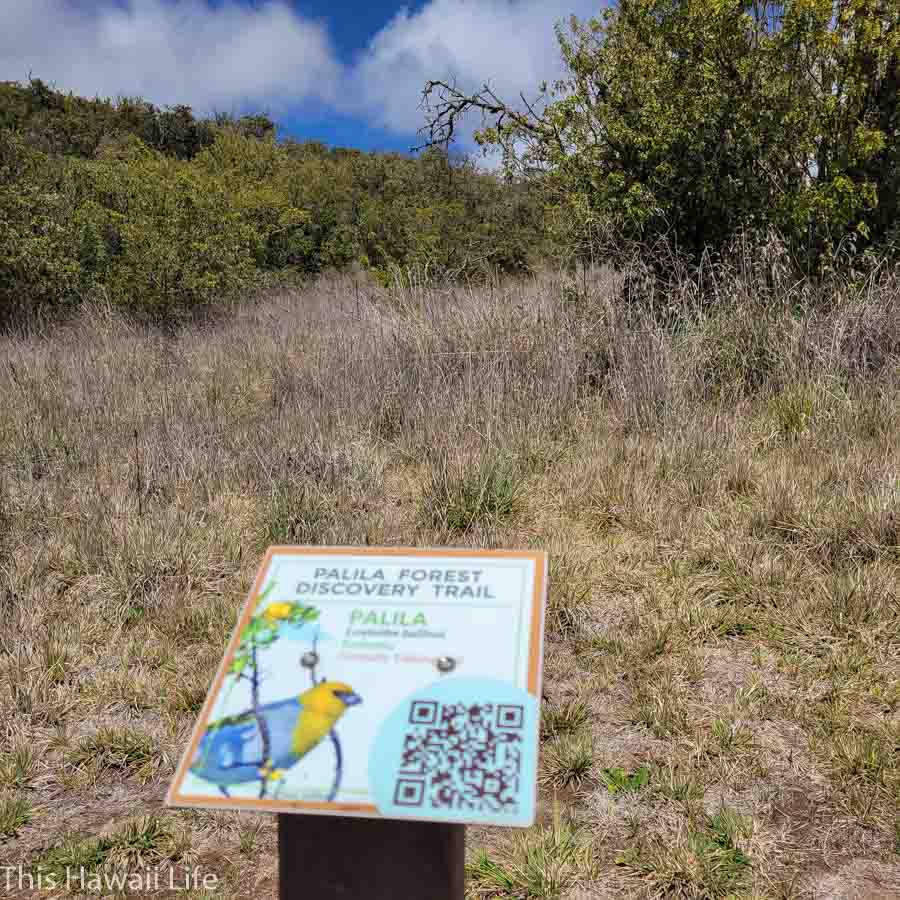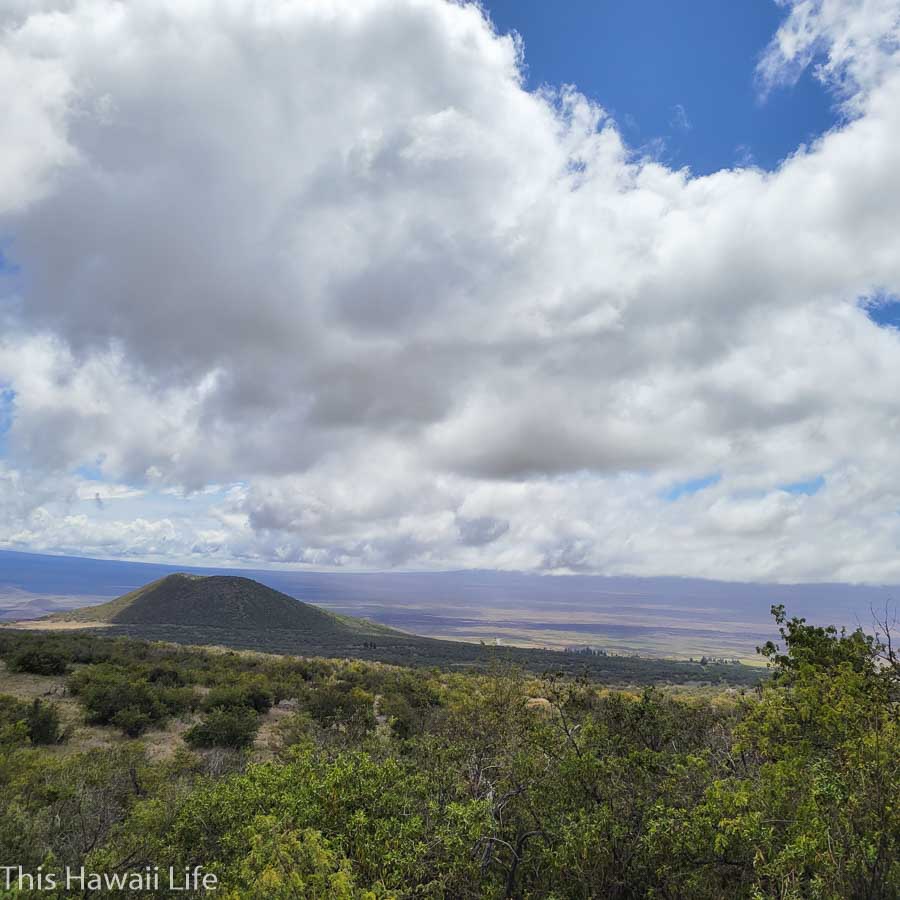A fantastic visit to the Palila Forest Discovery trail on the slopes of Mauna Kea and spectacular hikes and views (updated 2023)
One of the fantastic bird discovery trails and ecological projects taken on by Hawaii Island and Island Conservancy is the Palila Forest Discovery Trail. A revered forest located on the western flanks of Mauna Kea, the Palila Forest is a sacred sanctuary that is helping to protect the endemic Palila bird and other native bird species from becoming extinct on Hawaii Island. The pubic is allowed to visit the sanctuary with some careful entry requirements to visit the forest and observe many of the native birds still survive in this dryland forest.
A high elevation dry forest on Mauna Kea, the Palila Forest Discovery Trail is a special place where you will see plants and birds found nowhere else in the world. One of the largest tracts of dry forest left in all of Hawaii, the area and trail is dedicated to the preservation of the home of the endangered bird, the Palila including the Mamane tree of which only 5 percent survive on the Big Island of Hawaii.

The endemic Palila bird
This dry forest is the home of the Palila bird, the only place left in Hawaii that hosts this bird along with other endemic birds of Hawaii. The Palila (Loxioides bailleui) is one of those endangered birds of Hawaii and belongs to the Honeycreeper family. This colorful bird is a beautiful yellow gold on its head and breast with light grey and white in the front to bottom chest area, the wings are typically grey with green tips. The Palila live in an area of elevation on Mauna Kea from 6,500 to 9,500 feet and only survives where the Mamane trees still grow on the slopes. The Palila has a diet from mostly the Mamane tree which is still abundant in the dry forest areas of Mauna Kea and eats over 90 percent of this tree, flowers and seeds for its sustenance. It also eats māmane–naio for the rest of 10 percent of its diet.
Some of the other birds found in the park are endemic and also introduced to Hawaii and this includes the Iiwi, Apapane, Hawaii Amakihi, Hawaii Elepaio, House finch, Red billed Leiothrix, common myna, Warbling white eye, turkey and California Quail are the most common found in this conservation park.

A brief background to the Palila Forest Discovery Trail
Located on the flanks of Mauna Kea at the 7,000 foot elevation is the Palila Forest Discovery Trail. A joint project of the Hawaii DLNR’s Mauna Kea Forest Restoration Project and the American Bird Conservancy, the trail is less than 1 mile loop from native habitat and the mamane tree which represents about 5 percent of remaining mamane trees left on the island.
This dryland forest receives less than 20 inches of rain yearly and can be reached by AWD vehicles to the parking lot area. There is a fantastic entrance signage to give an overview and requirements to entering the park grounds and along the trails are wonderful small signs with QR codes you can scan to learn more about the forest, plants, birds and other interesting facets of hiking this wonderful trail area.
The Mamane tree and Palila would have been decimated if not for forward thinking conservationists that helped to plant more Mamane trees on Mauna Kea in the early 1930s. This has been an ongoing struggle with the introduction of sport game like the mouflon sheep, mongoose and feral cats that survive in this area and disturb both the Mamane and endemic birds in the park area.

Hiking trail
With rolling hills and an easy trail to follow, the dry forest area is scenic and wonderful views below of the Saddle Road area and you can actually spot four of the active volcanoes of Hawaii from several vantage points.
Along the approximately one mile loop trail are information stands with QR codes that lets you in on the native flora and fauna and some really interesting history, culture and sacred natural space called wao akua (realm of the gods) and revered by native Hawaiians and only visited by the Alii (rulters), or kahuna kalai pohaku (expert adze makers). The native Hawaiian stone was used to create stronger tools and weapons for use by Hawaiian solders and other native peoples.

Along the loop are fence ladders you climb around the protected fence areas.

How to spot the Palila bird
Most track the Palila bird through their distinct sounds they make through their call and sounds like this below. They are quite elusive but since they are one of the largest honeycreepers alive, they can be spotted when you carefully hear their sounds and follow to their location.
Tip – It’s good to bring binoculars so you can spot the birds and details better especially since the park is filled with Amakihi which can look a little similar especially in flight.
Native flora at Palila Forest Discovery Trail

Heavenly scented Sandlewood trees

The typical flora you’ll find at the Palila Forest Discovery Trail
While you are hiking around the Palila Forest Discovery Trail on the Big Island of Hawaii is housed within a unique and fragile ecosystem, showcasing a variety of native flora that has adapted to the island’s upland forests.
Here are some typical flora you may encounter along the trail:
Mamane (Sophora chrysophylla): Mamane trees are a keystone species in this ecosystem. Their vibrant yellow flowers and distinctive pinnate leaves provide essential food for the endangered Palila bird. The seeds of the mamane tree are also a significant food source for the Palila.
Naio (Myoporum sandwicense): Naio is a hardy, drought-resistant shrub with small, aromatic leaves and tiny white or lavender flowers. It’s well-adapted to the dry and windy conditions of the Mauna Kea slopes.
Ōhiʻa Lehua (Metrosideros polymorpha): This iconic Hawaiian tree features striking red or yellow flowers called “lehua,” which are often associated with Hawaiian legends and culture. It’s a vital species for native Hawaiian birds and insects.
Koa (Acacia koa): The koa tree is a giant of the Hawaiian forests, known for its towering stature and distinctive bark. It’s a hardwood tree with fern-like leaves and provides valuable habitat for native birds.
Pukiawe (Leptecophylla tameiameiae): Pukiawe is a low-growing shrub with wiry branches and small, round leaves. It produces clusters of tiny pink or white flowers and plays a role in stabilizing the soil on the steep slopes.
Ferns: Various fern species, including the native hapuʻu (Hawaiian tree fern) and ama’u (sadleria), add lush greenery to the forest floor.
Native Grasses: Grasses like ma’o (Hawaiian cotton) and ko’oko’olau are adapted to the arid conditions and often feature delicate, colorful flowers.
Lichens and Mosses: Due to the cool and moist environment of the upland forest, you’ll also find a diversity of lichens and mosses clinging to tree trunks and rocks.
Endemic Species: Many of the plants you encounter on the Palila Forest Discovery Trail are endemic to Hawaii, meaning they are found nowhere else on Earth. These species have evolved in isolation and are essential components of Hawaii’s unique ecosystems.
As you hike the trail, take the time to appreciate the beauty and ecological significance of these native plants. They are not only visually striking but also play a vital role in preserving Hawaii’s biodiversity, making the Palila Forest Discovery Trail a valuable educational experience for visitors.
How to get to the Palila Forest Discovery Trail
Located about 40 miles east from Kona and 45 miles west of Hilo on the New Saddle Road. From the new Saddle Road Highway, take the old Saddle Road extension going towards Waimea for approximately 1 mile uphill. One the right-hand side of the road is the marker for the Kilohana hunting station (between mile marker 43 and 44) and enter that road called Puʻu Lāʻau (R-1) Road. Follow R-1 continue uphill for another 4 miles to the parking lot and entrance gate.


Things to bring with you hiking Palilo Discovery trail
This is a simple and easy hike to do and you can combine with a variety of hikes around the Kilohana park area. Mostly sunny but mild temperatures, here are some things to consider bring with you along with water and food or snacks.
Hi vision binoculars for bird watching
Extra wide hat cover – sun and water proof

More details to hiking around the Big Island
Prepare and bring plenty of sunscreen, water and cover for hot exposed areas
Stay on the trails for your safety
Check out the trail heads information, kiosk or maps or any visitors center or rangers station
Remember to leave no trace behind and bring out everything you pack in.
Practise good hiking etiquette when your outdoors.
Bring food and water since there are no concessions and make sure to pack out your own trash.
Areas of the Big Island have unique indigenous trees that are being damaged by viruses, make sure to use the cleaning stations for your hiking shoes to prevent any viruses to attach to your shoes.
Check these other posts about the Big Island
Best hikes around the Big Island
Must visit waterfalls of the Big Island
Free or cheap things to do around the Big Island
Best snorkeling spots around the Big Island

Conclusion to visiting the Palila Forest Discovery Trail
Hope you enjoyed reading about the Palila Forest Discovery Trail. Even if you are not a birder, this fascinating dry land forest is wonderful to visit on the flanks of Mauna Kea and really worth a visit. Thanks again for checking out the post and if you enjoyed it please do share it with the social media buttons below.
Disclosure – This post may contain affiliate links which means if you click through and make a purchase I will make a small commission at no extra cost to you and you help to keep our site operating and updated – thank you!
Mahalo again for visiting This Hawaii Life.


0 Comments
Trackbacks/Pingbacks